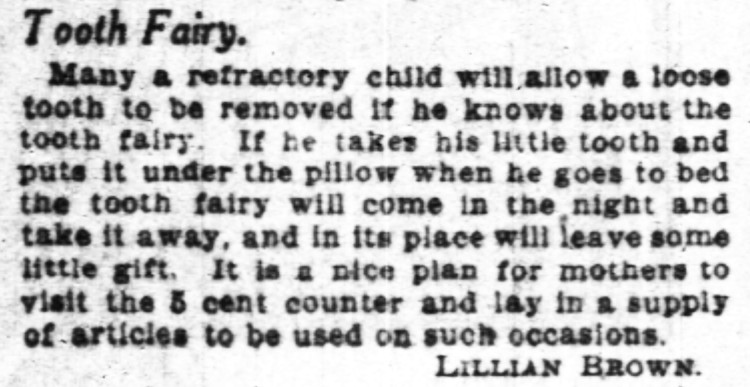The term tooth fairy denotes a fairy believed by children to take away milk teeth and leave a small sum of money or a small gift under the child’s pillow.
The earliest instance that I have found is from the Practical Housekeeper’s Own Page, in The Chicago Sunday Tribune (Chicago, Illinois) of 27th September 1908:
Tooth Fairy.
Many a refractory child will allow a loose tooth to be removed if he knows about the tooth fairy. If he takes his little tooth and puts it under the pillow when he goes to bed the tooth fairy will come in the night and take it away, and in its place will leave some little gift. It is a nice plan for mothers to visit the 5 cent counter and lay in a supply of articles to be used on such occasions.
Lillian Brown.

The second-earliest occurrence of tooth fairy that I have found is from the beginning of My Visit To Fairyland, by a 15-year-old girl named Nellie May Hans, published in the Literary Club, in The Courier-Journal (Louisville, Kentucky) of Sunday 14th May 1911:
When I was about 6 years of age my aunt told me if I would let her pull my tooth she would tell the “Tooth Fairy” to come and get it and leave me a present instead.
That night I wrapped up the tooth and put it under my pillow. After I had fallen asleep the “Tooth Fairy” came over to my bed, picked up the tooth and said to me, “Nellie May, would you like to go to Fairyland with me?”
Mothers invented other kinds of fairies, according to the following from the Woman’s Section of The South Bend Tribune (South Bend, Indiana) of Sunday 27th June 1926:
“Now that the measles are about over—” so begins much of the conversation about bridge tables these days. And speaking of measles—
Not long ago Madame Kay lunched with a well-known woman lecturer at the Joan shop. It was an informal affair previous to a meeting at the South Bend Woman’s club, and in the course of the conversation, which centered about child welfare, the lecturer asked the young mothers present whether or not fairies played any part in their children’s up-bringing.
It was then that the measles fairy, the chicken pox fairy, the vaccination fairy and a number of other fascinating personages came to light.
The measles fairy, one young mother explained, comes as soon as the wee invalid “breaks out.” Likewise the chicken pox fairy comes at that particular time to make life more endurable for the sick child. A gift is left beneath the pillow as proof of the fairy’s visitation. Then, it would never do to forget the tooth fairy! A baby tooth is easily pulled when one is sure that it can be wrapped in paper, slipped under the pillow, and transformed overnight into a fascinating new toy.
The following is from an account by Dr. Catherine Lindsay Wynekoop* of her childhood days, published on Wednesday 13th December 1933 by many newspapers—here, by the Beaumont Journal (Beaumont, Texas):
INVOKED TOOTH FAIRY
Another delight in our home was the Tooth Fairy. Whenever any of us lost a tooth, we carefully placed it in an envelope, together with a letter to the Tooth Fairy, telling what we desired in exchange for the tooth.
The letter was placed under the pillow at night and in the morning there would be the “reward” in place of the tooth. The day after a tooth had been lost, therefore, always was one of rejoicing.
Going through some of mother’s things the other day, I came upon a box containing small teeth and several crumpled notes addressed to “Mr. Tooth Fairy,” in large, childish handwriting.
(* Catherine was the daughter of Alice Lois Lindsay Wynekoop (1871-1955); the latter, a physician, professor, feminist, civic leader and educator in child hygiene, was convicted of the murder of her 22-year-old daughter-in-law, Rheta Gretchen Gardener Wynekoop, who died in November 1933.)
